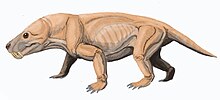| Moschorhinus Temporal range: Late Permian–Early Triassic
| |
|---|---|

| |
| Restoration of Moschorhinus kitchingi | |
| Scientific classification | |
| Domain: | Eukaryota |
| Kingdom: | Animalia |
| Phylum: | Chordata |
| Clade: | Synapsida |
| Clade: | Therapsida |
| Clade: | †Therocephalia |
| Family: | †Akidnognathidae |
| Genus: | †Moschorhinus Broom, 1920 |
| Species: | †M. kitchingi
|
| Binomial name | |
| †Moschorhinus kitchingi Broom, 1920
| |
| Synonyms | |
| |
Moschorhinus is an extinct genus of therocephalian synapsid in the family Akidnognathidae with only one species: M. kitchingi, which has been found in the Late Permian to Early Triassic of the South African Karoo Supergroup. It was a large carnivorous therapsid, reaching 1.1–1.5 metres (3.6–4.9 ft) in total body length with the largest skull comparable to that of a lion in size, and had a broad, blunt snout which bore long, straight canines.
Moschorhinus appears to have ecologically replaced the gorgonopsids as an apex predator, and hunted much like a big cat. While most abundant in the Late Permian, it survived into the Early Triassic in small numbers after the Permian Extinction, though these Triassic survivors had stunted growth.
- ^ Groenewald, D. P.; Kammerer, C. F. (2023). "Re-identification and updated stratigraphic context of the holotypes of the late Permian tetrapods Dicynodon ingens and Scymnosaurus warreni from KwaZulu-Natal". Palaeontologia Africana. 56: 171–179. hdl:10539/37143.